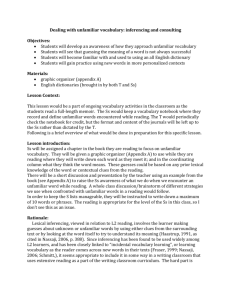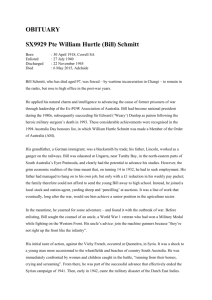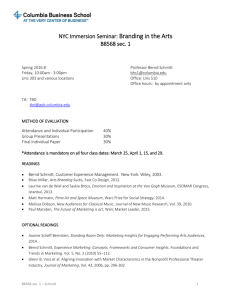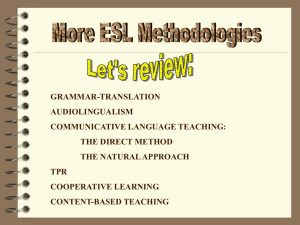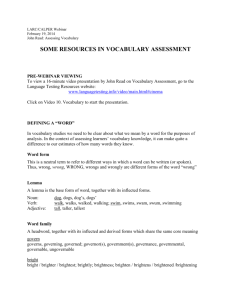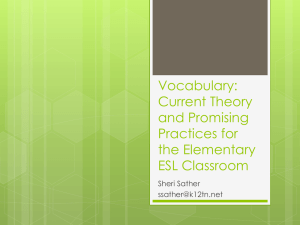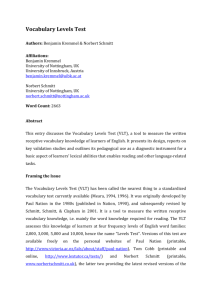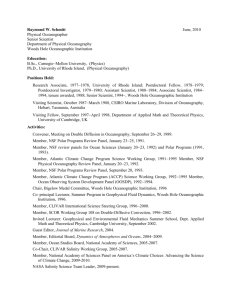Penny-Ur-Vocabulary
advertisement
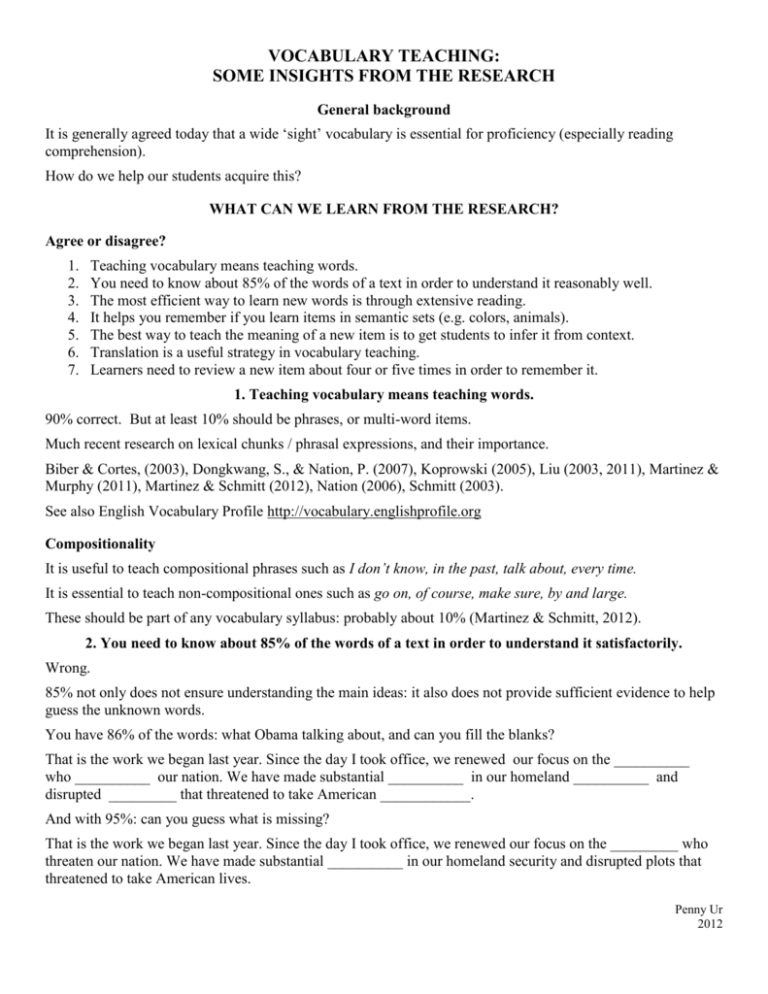
VOCABULARY TEACHING: SOME INSIGHTS FROM THE RESEARCH General background It is generally agreed today that a wide ‘sight’ vocabulary is essential for proficiency (especially reading comprehension). How do we help our students acquire this? WHAT CAN WE LEARN FROM THE RESEARCH? Agree or disagree? 1. 2. 3. 4. 5. 6. 7. Teaching vocabulary means teaching words. You need to know about 85% of the words of a text in order to understand it reasonably well. The most efficient way to learn new words is through extensive reading. It helps you remember if you learn items in semantic sets (e.g. colors, animals). The best way to teach the meaning of a new item is to get students to infer it from context. Translation is a useful strategy in vocabulary teaching. Learners need to review a new item about four or five times in order to remember it. 1. Teaching vocabulary means teaching words. 90% correct. But at least 10% should be phrases, or multi-word items. Much recent research on lexical chunks / phrasal expressions, and their importance. Biber & Cortes, (2003), Dongkwang, S., & Nation, P. (2007), Koprowski (2005), Liu (2003, 2011), Martinez & Murphy (2011), Martinez & Schmitt (2012), Nation (2006), Schmitt (2003). See also English Vocabulary Profile http://vocabulary.englishprofile.org Compositionality It is useful to teach compositional phrases such as I don’t know, in the past, talk about, every time. It is essential to teach non-compositional ones such as go on, of course, make sure, by and large. These should be part of any vocabulary syllabus: probably about 10% (Martinez & Schmitt, 2012). 2. You need to know about 85% of the words of a text in order to understand it satisfactorily. Wrong. 85% not only does not ensure understanding the main ideas: it also does not provide sufficient evidence to help guess the unknown words. You have 86% of the words: what Obama talking about, and can you fill the blanks? That is the work we began last year. Since the day I took office, we renewed our focus on the __________ who __________ our nation. We have made substantial __________ in our homeland __________ and disrupted _________ that threatened to take American ____________. And with 95%: can you guess what is missing? That is the work we began last year. Since the day I took office, we renewed our focus on the _________ who threaten our nation. We have made substantial __________ in our homeland security and disrupted plots that threatened to take American lives. Penny Ur 2012 2 Original text: That is the work we began last year. Since the day I took office, we renewed our focus on the terrorists who threaten our nation. We have made substantial investments in our homeland security and disrupted plots that threatened to take American lives. Researchers estimate you need to know 95%-98% of the words of a text in order to understand it satisfactorily. Ho et al. (2000), Huckin & Coady (1999), Schmitt et al. (2010), Staer (2009). The most recent studies suggest nearer 98% (Schmitt & Schmitt, 2012). But probably less for informal spoken discourse. 3. The most efficient way to learn new words is through extensive reading. Wrong. We learn new items very slowly through extensive reading. Bill Grabe found he learnt about 350 new items after reading 3 hours a day for 5 months, i.e. about 450 hours (Stoller & Grabe, 1997) Learners pick up about 1 word per 1,000 read (Zahar et al., 2001) There is a 50% chance of recognizing a new word 3 months later if it has been encountered in reading 8 times; Items encountered only once will be forgotten (Waring & Takaki, 2003). Other similar studies or summaries: Cobb (2007), Laufer (2003), Pigada & Schmitt (2006), Schmitt (2008). 4. It helps you remember if you learn items in semantic sets (e.g. colours, animals) Wrong. Learning lists of words that all mean the same sort of thing and are the same part of speech is not conducive to good learning. Research on learning semantic sets Tinkham (1993): Does it help learners to master a new set of lexical items if they are all members of a semantic set (same part of speech, same kind of meaning: e.g. clothes, animals)? Learners were presented with two sets of items from an artificial language, and told their ‘meanings’; one set all related to the same domain, the other did not. The learners consistently learned the unrelated items better. The research was later replicated by other researchers, with similar result: Waring (1998), Erten & Tekin (2008), Papathanasiou (2009) But words linked to each other syntagmatically are learnt well.e.g. blue + sky is better learnt than blue + red + yellow… 5. The best way to teach the meaning of a new item is to get students to infer it from context Wrong. ‘Inferencing’ is not reliable (Bensoussan & Laufer (2005), Laufer (1997), Nassaji (2003). ‘Inferencing’ does not aid retention (Mondria (2003)) One group was asked to learn words through inferencing from a ‘pregnant’ context and verifying with a glossary, and was then given time to memorize. The other group was simply provided with L1 translations and given time to memorize. Penny Ur 2012 3 When tested, the two groups achieved the same scores, which were maintained in a delayed post-test. But the inferencing + checking took much longer. So why use it? 6. Translation is a useful strategy in teaching vocabulary Right. Laufer (1997b): L1 glosses tend to produce better remembering than L1 glosses. Laufer and Girsai (2008): words practised using translation techniques into/from L1 were consistently better retained than those practised through L2-based exercises. 7. Learners need to review a new item about four or five times in order to remember it. Not enough. The evidence is that learners usually need at least ten (maybe more) meaningful encounters in order to acquire a new item. Horst & Meara (1999), Waring & Takaki (Webb (2007), Zahar et al. (2001) What does this mean in practice? WHAT DOES THIS MEAN IN PRACTICE? 1. Multi-word constructs Phrases, or ‘chunks’: combinations of words that go together to make a single concept, retrieved as a single unit from memory: of course, as well, take advantage of, right away… Collocations: words that ‘prefer’ specific other words with them: do + homework (not make); a high (not tall) mountain; rosy + cheeks Practical implications Look out for lexical chunks and collocations in texts, draw students’ attention to them. When teaching a new word, teach also the commonest collocations (e.g. afraid + of). Make sure any list of vocabulary to learn includes multi-word combinations as well as single words. 2. Large amount of vocabulary needed In order to understand unsimplified texts, students will need by the end of their schooling to know something like 8,000 word families (+ ‘chunks’). This means if they learn English for 8 years, they need about 1,000 items a year. 25 a week? Practical implications Don’t expect students to be able to understand texts where they know less than 95%. Invest classroom time inn vocabulary expansion. Make sure you cover the commonest and most useful items (check with English Vocabulary Profile http://vocabulary.englishprofile.org). Use vocabulary expansion activities as well as vocabulary from texts. o ‘Word of the day’ o ‘Show and tell’ o Brainstorm round a theme o Synonyms, antonyms of words already learnt o Look up a word you know: find more meanings, phrases, collocations For more ideas, see Ur (2012). Penny Ur 2012 4 3. Extensive reading does not ensure adequate acquisition of vocabulary Extensive reading is important for consolidating items already learnt, increasing reading fluency, enjoyment and motivation. But extensive reading texts should therefore be easier than the reading texts in their coursebooks (‘i-1’). Practical implications We need to supplement extensive reading by vocabulary activities: both presentation and review, both in class and for homework. It is suggested that about 1/3 of classroom time should be devoted to focused vocabularyteaching activities. 4. Semantic sets Presenting new items in ‘semantic sets’ does not lead to good learning. But many elementary textbooks do in fact include these (convenient to teach). Practical implications In principle, teach items thematically linked (different parts of speech, ‘chunks’ as well as single words), not lists of similar words. If your book teaches semantic sets, choose which are the most important and link them to other parts of speech in contexts: o What things can you see in this room that are red? o What can your hands do that your feet can’t? Skip the rare items in the larger sets e.g purple in colours, toes in parts of the body Try to avoid teaching together as new items: near-synonyms (ceiling, roof), antonyms (buy, sell), homonyms (bear, bear) , words easily confused (except, accept). But you CAN use such combinations – and lexical sets – as a basis for o teaching a new item (if the synonym, for example, is already well known) o review 5. Inferencing Inferring meaning from context (‘inferencing’) is an important skill for independent reading; but we need to distinguish between the use of inferencing as a reading strategy, and its use as a way of learning a new vocabulary item. For vocabulary-learning purposes it is a) not very reliable (in most cases students guess wrong) and b) timeconsuming. Practical implications Don’t expect students to infer meaning on their own unless the context makes it absolutely clear! Just provide the meanings yourself (or elicit from a knowledgeable member of the class). 6. Translation is a useful vocabulary-teaching strategy It can be used for practice or for testing; but its main use is in initial introduction of meaning. Penny Ur 2012 5 Translation is quick and likely to be accurate, provides a feeling of security and is a natural strategy. Practical implications Supplement pictures by quick translation. Replace lengthy English explanations by translation: the time you have saved can be used for using the target item in English in different contexts. 7. The importance of review A new item will only be remembered after it has been reviewed 10 or more times. But coursebooks do not usually provide this. The best review is through retrieval, provided this is success-oriented (i.e. students can, with an effort, retrieve the item they’ve been taught) (Karpicke & Roediger, 2008) Vocabulary notebooks are an excellent basis for review (Walters & Bozkurt, 2009). Practical implications We need to tell students to keep vocabulary notebooks / cards and review at home Provide plenty of retrieval-based review activities. For example: How many can you remember? Bilingual dictations Recall and share Quick Bingo Make up sentences including the items Make up a story including the items For more ideas, see Ur (2012) Summary Vocabulary knowledge is crucial for our students’ success in English; We need to be aware of how vocabulary is most effectively taught and learnt, and use our knowledge to inform practical classroom technique, coursebook selection and adaptation, and use of supplementary materials. References Bensoussan, M., & Laufer, B. (2005). Lexical Guessing in Context in EFL Reading Comprehension. Journal of Research in Reading, 7(1), 15-32. Biber, D & Cortes, V. (2004). 'If you look at...' lexical bundles in university teaching and textbooks. Applied Linguistics, 25(3), 371-405. Cobb, T. (2007). Computing the vocabulary demands of L2 Reading. Language Learning and Technology, 11 (3), 38-63. Dongkwang, S., & Nation, P. (2007). Beyond single words: the most frequent collocations in spoken English. ELT Journal, 62(4), 339-348. Penny Ur 2012 6 Erten, I. H., & Tekin, M. (2008). Effects on vocabulary acquisition of presenting new words in semantic sets versus semantically unrelated sets . System, 36 (3), 407-422. Hu, J., M. Cho & P. Nation. (2000). Unknown vocabulary density and reading comprehension. Reading in a foreign language, 13(1), 403-70. Huckin, T & J. Coady. (1999). Incidental vocabulary acquisition in a foreign language. Studies in Second Language Acquisition, 21(2), 181-93. Karpicke, J., & Roediger, H. L. (2008). The critical importance of retrieval for learning. Science, 319, 966-968. Koprowski, M. (2005). Investigating the usefulness of lexical phrases in contemporary coursebooks. ELT Journal, 59(4), 322-332. Laufer, B. (1997). The lexical plight in second language reading. Words you don’t know, words you think you know, and words you can’t guess. In J. Coady and T. Huckin (Eds.) Second language vocabulary acquisition: A rationale for pedagogy (pp. 20-34). Cambridge: Cambridge University Press. Laufer, B. (2003). Vocabulary acquisition in a second language: Do learners really acquire most vocabulary by reading? Some empirical evidence. The Canadian Modern Language Review, 59(4), 567-587. Laufer, B., & Girsai, N.. (2008). Form-focused instruction in second language vocabulary learning: A case for contrastive analysis and translation. Applied Linguistics, 27(4), 694-716. Liu, D. (2003). The most frequently used spoken American English idioms:a corpus analysis and its implications. TESOL Quarterly, 37(4), 671-700. Liu, D. (2011). The most frequently used English phrasal verbs in American and British English: A multicorpus examination. TESOL Quarterly, 45(4), 661-688. Martinez , R., and Schmitt, N. (2012) A phrasal expressions list. Applied Linguistics, 33 Martinez, R., & Murphy, V. (2011). Effect of Frequency and Idiomaticity on Second Language Reading Comprehension. TESOL Quarterly, 45 (2), 267-290. Mondria, J- A (2003). The effects of inferring, verifying and memorizing on the retention of L2 word meanings. Studies in Second Language Acquisition, 25 (4), 473-499. Nassaji, H. (2003). L2 vocabulary learning from context: Strategies, knowledge sources and their relationship with success in L2 lexical inferencing. TESOL Quarterly, 37(4), 645-670. Nation, I. S. P.. (2006). How large a vocabulary is needed for reading and listening? The Canadian Modern Language Review, 63 (1), 59-82. Papathanasiou, E. (2009). An investigation of two ways of presenting vocabulary. ELT Journal, 63(4), 313-322. Pigada, M., & Schmitt, Norbert. (2006). Vocabulary acquisition from extensive reading: A case study. Reading in a foreign language, 18(1), 1-28. Schmitt, N. (ed.). (2003). Formulaic Sequences. Amsterdam / Philadelphia: John Benjamins Publishing Company. Schmitt, N. (2008) Instructed second language vocabulary learning. Language Teaching Research, 12, 3, 329363. Schmitt, N., & Sonbul, S. (2010). Direct teaching of vocabulary after reading: is it worth the effort? ELT Journal, 64(3), 253-260. Penny Ur 2012 7 Schmitt, N., Jiang, X., & Grabe, W. (2010). The Percentage of Words Known in a Text and Reading Comprehension. The Modern Language Journal, 95(1), 26-43. Schmitt, N., & Schmitt, D. (2012). A reassessment of frequency and vocabulary size in L2 vocabulary teaching. Language Teaching, 45, 1-20. Barcroft, J.(2007). Effects of opportunities for word retrieval during second language vocabulary learning. Language Learning, 57 (1), 35-56. Staer, L. S.. (2009). Vocabulary knowledge and advanced listening comprehension in English as a foreign language . Studies in Second Language Acquisition, 31, 577-607. Tinkham, T. 1993. The effects of semantic and thematic clustering in the learning of second language vocabulary. Second Language Research 13(2), 138-63. Ur, P. (2012). Vocabulary activities. Cambridge: Cambridge University Press. Walters, J. And Bozkurt, N. (2009). The effect of keeping vocabulary notebooks on vocabulary acquisition . Language Teaching Research, 13(4), 403-423. Waring, R. 1998. The negative effect of learning words in semantic sets: a replication. System 25(2), 261-74. Waring, R. & Takaki, M. (2003). At what rate do learners learn and retain new vocabulary from reading a graded reader? Reading in a Foreign Language, 15(2), 130-163. Webb, S. (2007). The effects of repetition on vocabulary knowledge. Applied Linguistics, 28(1), 46-65. Zahar, R, T. Cobb & N. Spada. ( 2001). Acquiring vocabulary through reading: effects of frequency and contextual richness. Canadian Modern Language Review , 57(4), 544-72. Penny Ur 2012

